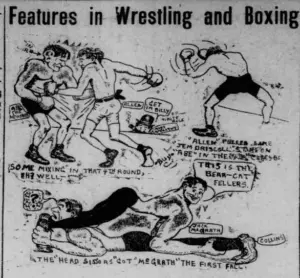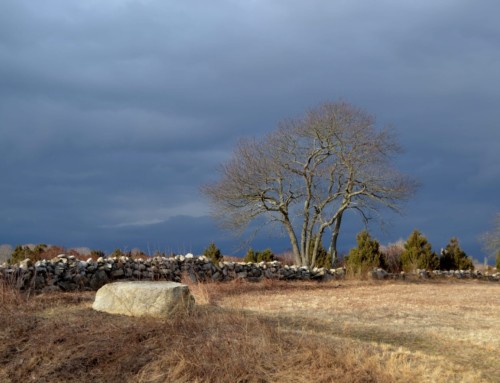When one thinks of professional wrestling as it exists today (of which this author is admittedly a large fan), it usually conjures notions of pageantry, fast-paced action, and over the top characters, but it was not always this way. The concept of professional wrestling is one that is centuries old and was rather popular in New England more than a century ago.
One facet of professional wrestling as it existed in the 1910s which still remains to this day is the concept of “babyfaces vs. heels” (fan favorites and villains). At the turn of the century, there were several wrestlers who were well-known to Westerly residents, but two men stood out as the most prolific competitors for many years, Bill Collins, a celebrated competitor, and “Yankee” Rogers, a man who would stoke the ire of many local fans.
Due to the transient nature of the profession, with wrestlers moving around and competing in matches across New England throughout the year, very little can be found regarding Bill Collins’ early life, or for that matter, his later life. Collins is said to have been born in 1889 based on a 1913 court statement in which he claimed to be 24 years old.[1]

That same month, there were some in Westerly who began to question the violence of these matches, particularly when another locally-revered competitor, Jack “The Irish Giant” McGrath was barred from wrestling in Westerly because “his style is too strenuous.”[6] This claim was particularly interesting when one considers that, professional wrestling of this era bore more similarities to modern amateur wrestling than it does today.
Nearly all of the matches during the early 20th century were contested under two out of three fall rules and in at least some instances wrestlers were not “allowed to use the fingers or thumbs as it might prove serious.”[7] Interestingly, however, strangleholds were permitted. There is some uncertainty as to whether the results of these matches were predetermined, and if so, whether the public was aware of this fact. In several instances, it is said that wrestlers “agreed” to throw (or pin) their opponent in a preset amount of time, but it was not unusual for a competitor to place wagers on the outcome of their own matches so this may have simply meant that the wrestlers agreed to such a wager and not to an actual outcome.[8]
In February 1910, Bill Collins was in Providence where he signed an agreement to fight strongman Captain Charles Clayton in Providence on March 3, however, this match does not appear to have happened, as that day, he was at Pawcatuck Armory where he filled in for a bout with Jack McGrath when McGrath’s scheduled opponent, failed to appear. According to one summary of the fight, Collins was “in great condition and put up a strong defense against McGrath” but was he thrown three times in one hour by the mighty Irishman.[9]
In the Spring of 1911, Collins, previously a Connecticut resident, made a new home in Westerly and took up a position as a mixologist at a café and taught wrestling on the side while he recovered from a broken foot suffered during a match with Zeral Olansky.[10] Collins sought revenge against Olansky in a rematch in Holyoke, Massachusetts as well as other bouts in Massachusetts throughout the Spring.[11]
After taking the summer to rest, Bill Collins made his return to the mat when he challenged Oscar Samson to a match on Labor Day as part of Westerly’s festivities.[12] If anyone had questions about Collins’ conditioning, these questions were put to rest when he embarked on a tour of Vermont in the autumn of 1911.
In Newport, Vermont, Collins won two of three falls in a matchup that lasted over an hour, however, this would pale in comparison to his epic battle with Sandy Dryden when the first fall came after one hour and fifty-two minutes.[13] After a lengthy tour that took him across Vermont, Massachusetts, and parts of Canada, Collins returned to Westerly for a short rest after having competed three to four nights every week.[14]
Upon his return to Westerly, Collins set his sights on a battle with a notorious local competitor, Charles “Yankee” Rogers of Fall River. The men had met before, but this time, Rogers indicated that he would agree to fight Collins for a side bet and the entire gate receipts but he did not want to receive a cent of the profit if he could not defeat Collins.[15] On New Years Day, the two men met once again at the Ancient Order of Hibernians Hall in Westerly (current the Sharah Zedek Synagogue on Union Street), a popular venue for wrestling at the time.
The matchup was proclaimed “one of the best wrestling exhibitions seen in Westerly in some time.”[16] The match, described as “fast and clean all the way” with “clever work” results in each man getting one fall, leaving the audience pleased and showering the wrestlers with constant applause.[17] The following month, the two men were set to meet once again, in what may well have been Rogers’ final appearance in Westerly.[18]
In March 1912, an event transpired which led the Norwich Evening Bulletin to proclaim that wrestling “is now dead as the proverbial doornail and Charley ‘Yankee’ Rogers…killed it.”[19] Rogers, who had taken upon residence in Westerly and made friends with many local men, advertised a wrestling match at Bliven Opera House between nationally-known wrestler Dr. Ben Roller and John Perelli of Boston.
On the night of the event, Rogers and his friend Harry Parker provided a short exhibition of wrestling and showed films of other matches, but when the main event was set to begin, it was revealed that neither Roller nor Perelli were present and, in fact, they were likely not aware that they were even scheduled to be at the Opera House.[20] Fans immediately began to demand a refund, but the Opera House proclaimed that they merely rented the space to Rogers for the evening and they had no hand in the entertainment.
Rogers would then boldly proclaim that he had been made aware that Roller would not be present but at that time, he had already rented the venue and in order to fund the rental, he advertised Roller regardless.[21] After avoiding a riot in response to his trickery, Rogers boarded the very first train out of Westerly and it was said that he would not be wrestling in Westerly in the future.[22] A week later, it was reported that Rogers had not been seen in town since the incident and it is unlikely that he ever returned.[23]
After the downfall of the local wrestling scene at the hands of Charles Rogers, Bill Collins was to face his own adversity in 1912. In December of that year, Collins was stabbed by a man named Sam Royster and although the prospects for his recovery were said to be good, Collins still suffered immensely, being bed-ridden for several weeks after the incident. In fact, three weeks after the stabbing, Collins was still too weak to appear in court to give his side of the story, although several “men of leisure” appeared in the courthouse to see Collins.[24] Royster was eventually convicted and sentenced to two years in prison.[25]
Collins was involved in another incident in September 1917 in which a man named David Helme assaulted him with a knife while shouting “Sam Royster did a poor job, but I’ll do a better one!”[26] Adding to his plight, Collins was struck by an automobile in 1913 and when he brought suit against the driver to recover lost wages as a result of his injuries, the judge awarded Collins no damages.[27] It appears that Collins lived out his days in Connecticut with his wife and children. Collins is said to have died in 1944.[28]
Based on the available records, it is clear that for a relatively short span, Bill Collins and Yankee Rogers were two of the biggest names in Westerly’s sporting scene and were largely responsible for the rise and fall of professional wrestling in Westerly.
[su_accordion class=””] [su_spoiler title=”Footnotes” open=”no” style=”default” icon=”plus” anchor=”” class=””]
- “Westerly Slasher Held” Norwich Evening Bulletin, 4 January 1913.
- “Local Laconics” Norwich Evening Bulletin, 18 January 1909.
- Norwich Evening Bulletin, 9 April 1909.
- “Collins Meets Abe Again.” Norwich Evening Bulletin, 2 March 1909.
- “Collins Meets Abe Again.” Norwich Evening Bulletin, 2 March 1909.
- “McGrath Too Rough for Westerly” Norwich Evening Bulletin, 24 March 1909.
- “McGrath Gets Two on Chief Fighting Bear” Norwich Evening Bulletin, 27 December 1909.
- “Collins Signs With Clayton” Norwich Evening Bulletin, 17 February 1910.
- “Features in Wrestling and Boxing” Norwich Evening Bulletin, 4 March 1910.
- “Bill Collins Back in the Game Again” Norwich Evening Bulletin, 5 April 1911.
- “Bill Collins Back in the Game Again” Norwich Evening Bulletin, 5 April 1911.
- “Bill Collins Back into the Wrestling Game ” Norwich Evening Bulletin, 25 August 1911.
- “Bill Collins Had Successful Wrestling Tour” Norwich Evening Bulletin, 2 February 1912.
- Norwich Evening Bulletin, 25 January 1912.
- “Wants to Meet Collins” Norwich Evening Bulletin, 7 November 1911.
- “Collins Turned Tables on Charlie Rogers” Norwich Evening Bulletin, 2 January 1912.
- “Collins Turned Tables on Charlie Rogers” Norwich Evening Bulletin, 2 January 1912.
- “Parker Took Two Falls” Norwich Evening Bulletin, 16 February 1912.
- “Westerly Wrestling a Fizzle” Norwich Evening Bulletin, 23 March 1912.
- “Westerly Wrestling a Fizzle” Norwich Evening Bulletin, 23 March 1912.
- “Westerly Wrestling a Fizzle” Norwich Evening Bulletin, 23 March 1912.
- “Westerly Wrestling a Fizzle” Norwich Evening Bulletin, 23 March 1912.
- “Where Doc Roller Was” Norwich Evening Bulletin, 28 March 1912.
- “Collins Not in Court at Westerly” Norwich Evening Bulletin, 28 December 1912.
- “Prison for Westerly Stabber” Norwich Evening Bulletin, 18 February 1913.
- Norwich Evening Bulletin, 3 September 1917.
- “Two Decisions by Judge Reed” Norwich Evening Bulletin, 27 February 1914.
- Gravestone of Willard A. Collins, Evergreen Cemetery, Moosup, Windham County, Connecticut, https://www.findagrave.com/memorial/175663282/willard-a-collins.
[/su_spoiler] [/su_accordion]






